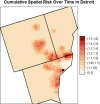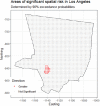Estimating mixture effects and cumulative spatial risk over time simultaneously using a Bayesian index low-rank kriging multiple membership model
- PMID: 36161724
- PMCID: PMC9691549
- DOI: 10.1002/sim.9587
Estimating mixture effects and cumulative spatial risk over time simultaneously using a Bayesian index low-rank kriging multiple membership model
Abstract
The exposome is an ideal in public health research that posits that individuals experience risk for adverse health outcomes from a wide variety of sources over their lifecourse. There have been increases in data collection in the various components of the exposome, but novel statistical methods are needed that capture multiple dimensions of risk at once. We introduce a Bayesian index low-rank kriging (LRK) multiple membership model (MMM) to simultaneously estimate the health effects of one or more groups of exposures, the relative importance of exposure components, and cumulative spatial risk over time using residential histories. The model employs an MMM to consider all residential locations for subjects weighted by duration and LRK to increase computational efficiency. We demonstrate the performance of the Bayesian index LRK-MMM through a simulation study, showing that the model accurately and consistently estimates the health effects of one or several group indices and has high power to identify a region of elevated spatial risk due to unmeasured environmental exposures. Finally, we apply our model to data from a multicenter case-control study of non-Hodgkin lymphoma (NHL), finding a significant positive association between one index of pesticides and risk for NHL in Iowa. Additionally, we find an area of significantly elevated spatial risk for NHL in Los Angeles. In conclusion, our Bayesian index LRK-MMM represents a step forward toward bringing the ideals of the exposome into practice for environmental risk analyzes.
Keywords: exposome; mixture analysis; non-Hodgkin lymphoma; residential history; spatial analysis.
© 2022 The Authors. Statistics in Medicine published by John Wiley & Sons Ltd.
Figures







Similar articles
-
Estimating cumulative spatial risk over time with low-rank kriging multiple membership models.Stat Med. 2022 Oct 15;41(23):4593-4606. doi: 10.1002/sim.9527. Epub 2022 Jul 11. Stat Med. 2022. PMID: 35816955 Free PMC article.
-
Spatial-temporal analysis of non-Hodgkin lymphoma risk using multiple residential locations.Spat Spatiotemporal Epidemiol. 2012 Jun;3(2):163-71. doi: 10.1016/j.sste.2012.04.009. Epub 2012 Apr 21. Spat Spatiotemporal Epidemiol. 2012. PMID: 22682442 Free PMC article.
-
Spatial-temporal analysis of non-Hodgkin lymphoma in the NCI-SEER NHL case-control study.Environ Health. 2011 Jun 30;10:63. doi: 10.1186/1476-069X-10-63. Environ Health. 2011. PMID: 21718483 Free PMC article.
-
Residential herbicide use and risk of non-Hodgkin lymphoma.Cancer Epidemiol Biomarkers Prev. 2005 Apr;14(4):934-7. doi: 10.1158/1055-9965.EPI-04-0730. Cancer Epidemiol Biomarkers Prev. 2005. PMID: 15824166 Review.
-
Occupational and environmental exposure to polychlorinated biphenyls and risk of non-Hodgkin lymphoma: a systematic review and meta-analysis of epidemiology studies.Eur J Cancer Prev. 2019 Sep;28(5):441-450. doi: 10.1097/CEJ.0000000000000463. Eur J Cancer Prev. 2019. PMID: 30234686
Cited by
-
Modeling historic environmental pollutant exposures and non-Hodgkin lymphoma risk.Environ Res. 2023 May 1;224:115506. doi: 10.1016/j.envres.2023.115506. Epub 2023 Feb 18. Environ Res. 2023. PMID: 36805898 Free PMC article.
-
Assessing and attenuating the impact of selection bias on spatial cluster detection studies.Spat Spatiotemporal Epidemiol. 2024 Jun;49:100659. doi: 10.1016/j.sste.2024.100659. Epub 2024 May 12. Spat Spatiotemporal Epidemiol. 2024. PMID: 38876558 Free PMC article.
-
The need for a cancer exposome atlas: a scoping review.JNCI Cancer Spectr. 2025 Jan 3;9(1):pkae122. doi: 10.1093/jncics/pkae122. JNCI Cancer Spectr. 2025. PMID: 39700422 Free PMC article.
-
Modeling variation in mixture effects over space with a Bayesian spatially varying mixture model.Stat Med. 2024 Mar 30;43(7):1441-1457. doi: 10.1002/sim.10022. Epub 2024 Feb 2. Stat Med. 2024. PMID: 38303638 Free PMC article.
-
Modeling Historic Arsenic Exposures and Spatial Risk for Bladder Cancer.Stat Biosci. 2024 Jul;16(2):377-394. doi: 10.1007/s12561-023-09404-7. Epub 2023 Dec 17. Stat Biosci. 2024. PMID: 39247147 Free PMC article.
References
-
- Wild CP. Complementing the genome with an “exposome”: the outstanding challenge of environmental exposure measurement in molecular epidemiology. Cancer Epidemiol Prev Biomarkers. 2005;14(8):1847‐1850. - PubMed
-
- de Vuijst E, van Ham M, Kleinhans R. A life course approach to understanding neighbourhood effects. IZA Discussion Paper #10276; 2016.
-
- Wild CP, Turner PC. The toxicology of aflatoxins as a basis for public health decisions. Mutagenesis. 2002;17(6):471‐481. - PubMed
-
- Colt JS, Severson RK, Lubin J, et al. Organochlorines in carpet dust and non‐Hodgkin lymphoma. Epidemiology. 2005;16:516‐525. - PubMed
Publication types
MeSH terms
Grants and funding
LinkOut - more resources
Full Text Sources
